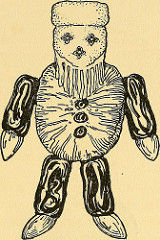President Donald Trump
Old Marshmallow Experiment Illuminates Trump's Weaknesses
A 1960s study with kids reveals our president's dangerous inner child today.
Posted November 13, 2017
Remember the famous Marshmallow Experiment? In the late 1960s, researchers at Stanford University in California gave child after child a single marshmallow. They told each child that he or she could eat the marshmallow right away or wait 20 minutes and be given a second marshmallow. A video record is on YouTube; you can see lots of kids try ever so hard to be patient. You can also see some who don’t even bother to try.

The “failure” of so many children showed what psychologists call “delay discounting.” The prospect of waiting for the second marshmallow (that’s the “delay”) made children discount its value.
What the Stanford Marshmallow Experiment really measured is kids’ impatience. And it's possible that an adults-only version written up in 2008 holds clues to Donald Trump’s notorious haste—and, more importantly, his vulnerabilities. The study was designed and conducted by researchers at KULeuven in Belgium. In several distinct phases it produced important findings about sexual stimuli and about rewards of money and junk food in men.
Got that? Sex, money, and junk food. Sound like our president's appetites to you?
The 2008 Adults-Only Experiment
Phase 1A tested the effect of visual sex cues on impatience about money. The researchers sat 42 young men in individual cubicles and showed them pictures of pretty landscapes and of sexy women in swimsuits or lingerie. Then they administered a delay discounting experiment. (Similar in concept to the Stanford Marshmallow Experiment, men could choose to benefit from some money now or more money later.) Exposure to pictures of sexy women increased the men’s impatience about money. They wanted to “eat” their marshmallow-equivalent NOW.
Phase1B explored whether tactile sex cues also heighten delay discounting. The researchers sat 67 young men in cubicles and asked them to rate the appeal of eight different T-shirts and eight different bras. The men were invited to touch the T-shirts and bras. The same delay discounting test then measured each man’s impatience about monetary reward. Seeing bras increased impatience. So did touching bras.
Phase 2 tested whether men who are highly sensitive to reward in general are more likely to be influenced by sex cues. One hundred twenty young men sitting in cubicles actually got to do this: “[They] viewed a 1-minute advertising commercial. In the ‘control condition,’ the commercial video featured hundreds of men sprinting through scenery, and in the ‘sex cue condition,’ the commercial video contained hundreds of young women, dressed in bikinis, running across hills, fields, and beaches. Participants were instructed to watch the commercial carefully since they would be asked questions about it at a later point in time.”
Clever about the “pop quiz to come,” right?
After exposure in private cubicles to all that galumphing and jiggle, the men’s impatience for monetary reward was measured. Then their sensitivity was measured. (“Do you often do things to be praised? Y/N,” “Are you often afraid of new or unexpected situations? Y/N.” And so on. )
Once again, test scores showed that sex cues increase delay discounting; this was especially true for men who scored as being highly sensitive.
Phase 3 tested whether sex cues lead to more delay discounting when a real-world financial situation leads men to feel a need for fast cash. It also tested whether sex cues increase delay discounting of rewards that are not monetary. One hundred twenty-nine young men were asked to rate the T-shirts and bras from Phase 1B. They were also asked about the size of their actual monetary holdings.
This time, in the delay discounting test, candy and soda were used as rewards in addition to money. Once again, sensitivity was assessed. The bras significantly increased delay discounting, and that was true about candy and soda as well as about money. Men who scored as sensitive proved to be especially impatient about getting a reward. But men who had no real-world need for fast cash were not as impatient as those who felt relatively broke.
In concluding their paper in The Journal of Consumer Research, the Belgian investigators suggested that the whole experiment should be repeated with women as test subjects. But more importantly, they wondered whether rewards themselves should be evaluated for their potential as cues.
And so ....
The 2008 Experiment and Today's Trump
To be absolutely clear, in their 2008 paper the researchers said absolutely nothing about Donald J. Trump. (That year he was still donating to Democrats and complaining that "Hillary got 'schlonged'.") Still, their curiosity about whether rewards could also function as cues suggests much about how, one year into Donald Trump’s presidency, someone astute—or, heaven help us, nefarious—might try to disrupt our nation's political stability.
What we know:
- Sex cues increased delay discounting of money and food in sensitive men.
- Trump is sensitive. Remember his reaction to comments about his fingers and the size of his inauguration crowd? Now imagine his answer to “Do you often do things to be praised? Y/N,” “Are you often afraid of new or unexpected situations? Y/N.” And so on.
What we don't know:
- Whether Trump is sensitive enough to have his impatience manipulated by adjustments in sex cues.
- Whether Trump feels like he needs some fast cash.
- Whether adjustments of food and/or money cues can affect Trump’s impatience.
What a foreign agent might secretly do to:
- Give Trump all of the money, sex, and junk food he wants and see if that destabilizes him and the country. Caveat: He already has all of the money, sex, and junk food he wants.
- Take the opposite approach. Put him on a budget and a diet. Unplug his TV and Wifi and cancel his girlie magazine subscriptions. Under no circumstances should anyone let him watch a video of hundreds of young women, dressed in bikinis, running across hills, fields, and beaches.
Deprivation will probably produce a significant behavioral shift—though in what direction it’s hard to predict.
God help us all. And God bless America.
References
B. Van den Bergh, S. Dewitte, L Warlop (2008). Bikinis instigate generalized impatience in intertemporal choice. Journal of Consumer Research, (35: 1) 85–97.
R. Thaler (1981). Some empirical evidence on dynamic inconsistency. Economics Letters 8. 201-208.




